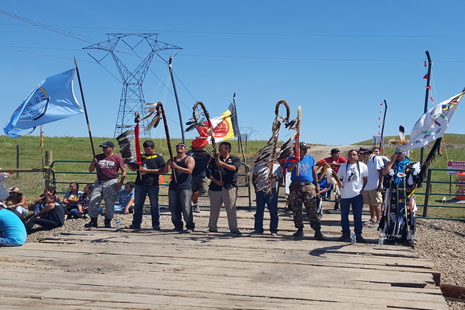Last June, I traveled to Moonstone Farm near Montevideo, Minnesota to participate in their annual women’s gathering. A ceremony was held there, wherein congregants combined water from sources important to us and pledged to defend the resource from harm. I brought water from Spirit Mound Creek, a stream named after a site sacred to the Dakota people and visited in 1804 by the Lewis and Clark Expedition. From Spirit Mound, the creek flows toward the Vermillion River, which in turn feeds the Missouri.
Later that summer, in August, the call came out for water protectors to help the Standing Rock Sioux Tribe defend the Missouri River from construction of the Dakota Access Oil Pipeline. The fight began in April, with the establishment of Sacred Stone Camp at the confluence of the Cannonball and Missouri Rivers, and now water protectors from across the country were traveling there. I messaged a friend about the possibility of going, and she replied, “There aren’t a lot of white people here. We need you to come and bear witness.”
I returned three times after that initial trip to Oceti Sakowin (Seven Council Fires) Camp. Each time,the experience was different as more people came and the season turned toward winter. There were comfortable times, sitting around the fire in shirtsleeves; there were moments of panic when, falling asleep in my frosty tent to the sound of drums, singing, and the ever-present drone of surveillance planes, the call came to “Get your children to a safe place! All water protectors report to the front line!” During one stay, I brought recording equipment to do interviews and ended up cooking instead—12-14 hour days in a makeshift tarp structure lit by lanterns, wood smoke so deep in my pores that it barely wore off in the week I was gone. When I returned, the cook tent was a huge enclosed shelter with a generator for lights, tables inside, and they were feeding five times as many.
There is a constant influx of famous people—artists and political figures, some of whom I only recognized after selfies were published on Facebook. The important people aren’t the ones who perform on stage, they are the indigenous people who work to protect and care for those in camp, provide guidance and resolve disputes, make sure a warm pair of boots gets to a person in need, support someone suffering from PTSD. Prayers spoken in camp meetings form a tangible band of warmth, encircling us all in community. And that is perhaps the most important piece of this struggle—it is more than the pipeline fight, more than the river, more than the stolen treaty lands—it is about re-establishing indigenous leadership and community based on the seven Lakota values of Prayer, Respect, Compassion, Honesty, Generosity, Humility, and Wisdom.
What would it be like if all our communities re-committed to practicing these values on a daily basis? Maybe it’s a way to forge common purpose and abandon the old prejudices and broken systems that are simultaneously cooking, drowning, and impoverishing the planet and its people. As my friend Chas Jewett, who first invited me to come and bear witness, said in a Minneapolis Star Tribune article: “We’re not going to solve the problem by getting to the drill pad and stopping them there. We’re going to stop the problem by convincing the hearts and minds of America that this is an unnecessary walk toward destruction.”
– By Rebecca Terk, a member of Dakota Rural Action. Reprinted from DRA’s ACTION REVIEW.

